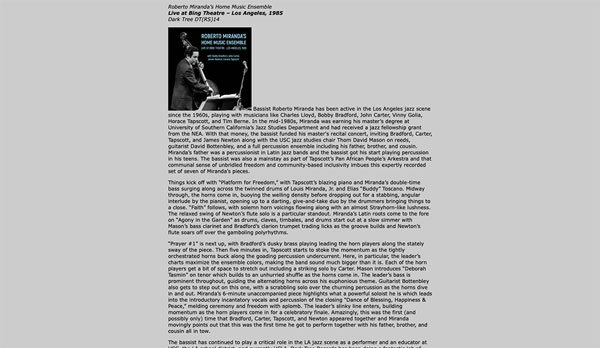• Michael Rosenstein // Point of Departure (juin 2021)
Bassist Roberto Miranda has been active in the Los Angeles jazz scene since the 1960s, playing with musicians like Charles Lloyd, Bobby Bradford, John Carter, Vinny Golia, Horace Tapscott, and Tim Berne. In the mid-1980s, Miranda was earning his master’s degree at University of Southern California’s Jazz Studies Department and had received a jazz fellowship grant from the NEA. With that money, the bassist funded his master’s recital concert, inviting Bradford, Carter, Tapscott, and James Newton along with the USC jazz studies chair Thom David Mason on reeds, guitarist David Bottenbley, and a full percussion ensemble including his father, brother, and cousin. Miranda’s father was a percussionist in Latin jazz bands and the bassist got his start playing percussion in his teens. The bassist was also a mainstay as part of Tapscott’s Pan African People’s Arkestra and that communal sense of unbridled freedom and community-based inclusivity imbues this expertly recorded set of seven of Miranda’s pieces.
Things kick off with “Platform for Freedom,” with Tapscott’s blazing piano and Miranda’s double-time bass surging along across the twinned drums of Louis Miranda, Jr. and Elias “Buddy” Toscano. Midway through, the horns come in, buoying the welling density before dropping out for a stabbing, angular interlude by the pianist, opening up to a darting, give-and-take duo by the drummers bringing things to a close. “Faith” follows, with solemn horn voicings flowing along with an almost Strayhorn-like lushness. The relaxed swing of Newton’s flute solo is a particular standout. Miranda’s Latin roots come to the fore on “Agony in the Garden” as drums, claves, timbales, and drums start out at a slow simmer with Mason’s bass clarinet and Bradford’s clarion trumpet trading licks as the groove builds and Newton’s flute soars off over the gamboling polyrhythms.
“Prayer #1” is next up, with Bradford’s dusky brass playing leading the horn players along the stately sway of the piece. Then five minutes in, Tapscott starts to stoke the momentum as the tightly orchestrated horns buck along the goading percussion undercurrent. Here, in particular, the leader’s charts maximize the ensemble colors, making the band sound much bigger than it is. Each of the horn players get a bit of space to stretch out including a striking solo by Carter. Mason introduces “Deborah Tasmin” on tenor which builds to an unhurried shuffle as the horns come in. The leader’s bass is prominent throughout, guiding the alternating horns across his euphonious theme. Guitarist Bottenbley also gets to step out on this one, with a scrabbling solo over the churning percussion as the horns dive in and out. Miranda’s 6-minute unaccompanied piece highlights what a powerful soloist he is which leads into the introductory incantatory vocals and percussion of the closing “Dance of Blessing, Happiness & Peace,” melding ceremony and freedom with aplomb. The leader’s slinky line enters, building momentum as the horn players come in for a celebratory finale. Amazingly, this was the first (and possibly only) time that Bradford, Carter, Tapscott, and Newton appeared together and Miranda movingly points out that this was the first time he got to perform together with his father, brother, and cousin all in tow.
The bassist has continued to play a critical role in the LA jazz scene as a performer and an educator at USC, the LA school district, and currently UCLA. Dark Tree Records has been doing a fantastic job of unearthing important archival recordings from the LA scene. Add this one to that worthy list.
• • • • • • • • • • • • • • • • • • • • • • • • • • • • • • • • • • • • • • • • • • • • • • • • • • • • • • • • • • • • • • • •

Sorry, the comment form is closed at this time.